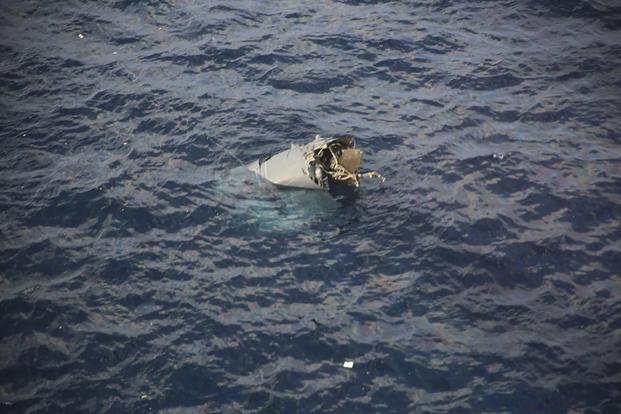The Air Force on Tuesday released the names of seven more crew members who perished last week during training when their CV-22 Osprey crashed into the ocean off the coast of southern Japan.
Days of search-and-rescue operations around Yakushima Island shifted to "search and recovery" of the aircraft wreckage and remains after it was deemed that survivors were unlikely, Air Force Special Operations Command said in a statement. Prior to Tuesday's statement, only one airman -- whose remains were located hours after the incident -- had been identified.
"Staff Sgt. Jake Galliher's remains were recovered Nov. 29, 2023, and the status of the seven remaining airmen transitioned from DUSTWUN (duty status-whereabouts unknown) to deceased status and all families were notified," Air Force Special Operations Command said.
Of the eight airmen on board the Osprey, the remains of three airmen had been recovered as of Tuesday, according to the Air Force. Three other remains have been located and are in the process of being retrieved. The remains of two of the crew members are still being sought.
The Nov. 29 incident marks the deadliest CV-22 crash in the Air Force's history and the largest loss of life on the service's airframe, according to Air Force Safety Center data.
The other crew members, alongside Galliher, were:
- Maj. Jeffrey T. Hoernemann, 32, of Andover, Minnesota, was a CV-22 instructor pilot and officer in charge of training, assigned to the 21st Special Operations Squadron, 353rd Special Operations Wing, Yokota Air Base, Japan.
- Maj. Eric V. Spendlove, 36, of St. George, Utah, was a residency-trained flight surgeon and medical operations flight commander assigned to the 1st Special Operations Squadron, 353rd Special Operations Wing, Kadena Air Base, Japan.
- Maj. Luke A. Unrath, 34, of Riverside, California, was a CV-22 pilot and flight commander assigned to the 21st Special Operations Squadron, 353rd Special Operations Wing, Yokota Air Base.
- Capt. Terrell K. Brayman, 32, of Pittsford, New York, was a CV-22 pilot and flight commander assigned to the 21st Special Operations Squadron, 353rd Special Operations Wing, Yokota Air Base.
- Tech. Sgt. Zachary E. Lavoy, 33, of Oviedo, Florida, was a medical operations flight chief assigned to the 1st Special Operations Squadron, 353rd Special Operations Wing, Kadena Air Base.
- Staff Sgt. Jake M. Turnage, 25, of Kennesaw, Georgia, was a flight engineer assigned to the 21st Special Operations Squadron, 353rd Special Operations Wing, Yokota Air Base.
- Senior Airman Brian K. Johnson, 32, of Reynoldsburg, Ohio, was a flight engineer assigned to the 21st Special Operations Squadron, 353rd Special Operations Wing, Yokota Air Base.
"In times like these, where service to our nation is not just a personal commitment but also a legacy woven into the fabric of our families, the depth of sorrow is immeasurable," Lt. Gen. Tony Bauernfeind, commander of Air Force Special Operations Command, said in a released statement. "The honorable service of these eight airmen to this great nation will never be forgotten, as they are now among the giants who shape our history."
On Monday, dive teams located the remains of five missing crew members as well as the main fuselage of the aircraft, the service said.
Last week, Air Force Special Operations Command said the CV-22B Osprey, assigned to the 353rd Special Operations Wing, was on a training mission off the shore of Yakushima Island -- between the Japanese mainland and Okinawa -- with the eight airmen aboard when it went down in the ocean.
Sabrina Singh, a Pentagon spokeswoman, said in a statement Friday that the Air Force unit that owned the Osprey had grounded its other Ospreys and additional inspections of the U.S. military's aircraft based in Japan were underway.
Japanese officials also voiced public concerns about the dual-rotor aircraft, which can fly like a helicopter or airplane, following the incident and called for their own country's fleet of Ospreys to be grounded.
It's not yet clear what caused last week's crash off Yakushima Island.
Prior to the training crash in Japan, the service lost three service members and a civilian contractor when an Osprey crashed in April 2010 near the city of Qalat in Afghanistan, according to Air Force Safety Center Data.
"An investigative board could not determine the cause of the 2010 mishap by the standard of 'clear and convincing evidence,' in part because the flight incident recorder, the Vibration Structural Life and Engine Diagnostics control unit, and the right engine were destroyed and therefore not available for analysis," the service said in a press release at the time.
Since the Osprey's first flight in 1992, it has been involved in numerous crashes, accidents and mishaps, leading to more than 60 deaths.
Just prior to the deadly Air Force crash, two Marine V-22 Ospreys in Japan diverted on Sept. 14 within just two hours of each other due to "cockpit caution indications" in the aircraft while flying near where the Air Force Osprey crashed this week.
A Marine Corps Osprey crashed in Australia in August, claiming the lives of three Marines. Another Marine Corps Osprey went down last year in Southern California, killing five Marines.
Investigation findings released in July showed the cause of that crash in California was a hard clutch engagement, or HCE, a mechanical issue that has plagued the aircraft for more than a decade.
Related: Air Force Says It Remains Confident in Osprey Aircraft Despite Recent Deadly Mishaps










